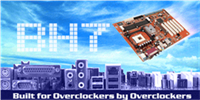|

 | | Gaming Benchmarks | | The proof is in the pudding...whatever than means | |
ID's Quake 3 Arena:
Even though there are newer games to use when benchmarking, no other test is as well used and well known as Quake 3 Arena. Although the scores have become more and more inflated, we still use this benchmark since it produces reliable results, and can give good comparisons between like systems and components. The latest benchmark routine consists of upgrading to the 1.32 point release, and then launching demo four from the console. We ran two sets of scores, one a "low quality" setup where the game was set to use a resolution of 640x480 using 16-bit color settings, and then again at a so-called "high quality", which was at 1024x768x32 with more robust graphical settings.  The four boards are, for the most part, evenly matched. The slight nod goes to the VIA P4PB Ultra with its five frames per second lead over the other three boards. At these speeds, however, this would be impossible to notice with the naked eye. Once we juiced the Abit BH7 up to 163MHz, we were able to get over 35 extra frames per second, topping out just shy of 275 fps.  Using the higher quality settings, the VIA board went from first to third, with the MSI board taking the top spot. The Abit BH7 came in second, three frames per second behind the VIA P4PB. Again, overclocking the BH7 pushed it up and over the competition, and gave us a frame rate that even beat all of the boards in the last test as well.
Novalogic's Comanche 4 Demo: A popular DirectX benchmarking program is Novalogic's Comanche 4. Since this benchmark is more CPU dependant than other games, the scores seem lower than what one usually expects from a gaming-type benchmark. However, we can get a good feel for the overall system performance by comparing the benchmarked results.  The scores at stock speeds followed the same pattern as with Quake 3 at 1024x768, with the MSI board layin' the smack down on the other boards, putting that extra memory bandwidth to use. The extra bandwidth results in a 4% increase over the nearest challenger, which turned out to be the BH7. The other two boards were following closely behind. Overclocking the BH7 gave us an extra 17% in performance by raising the frame rate by almost an additional 8 frames per second. Unreal Tournament 2003 Demo: A relative newcomer to the testing benchmark scene would be the Unreal Tournament 2003 demo. We ran the Antalus Fly-By Demo at the same three resolutions on all systems to see how well this card handled a more leading edge graphics engine. To aid us with this test, we used a "High Quality" scripts to automate the process.  The scores that we obtained at 1600x1200 were all within a few tenths of each other, all except the MSI 655 Max that is. One interesting score to point out is that overclocking the BH7 had little effect on the frame rates at the higher resolutions, which indicated that we were more or less being held back by the limitations of the video card. We were able to pick up a few frames at 1024x768, however.
Final benchmark routines and the Conclusion
|